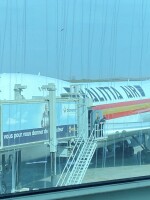The Ring Nebula, whose iconic shape and large size make it a favorite of amateur astronomers, can now be seen in new detail, after NASA's Hubble Space Telescope captured a sharp image of the nebula. Researchers say the new clarity reveals details that were previously unseen, and a structure that's more complex than scientists had believed.
"The nebula is not like a bagel, but rather, it's like a jelly doughnut, because it's filled with material in the middle," says C. Robert O'Dell of Vanderbilt University, who leads a team of researchers studying the Ring Nebula. They combined Hubble's visible-light images with infrared data from telescopes on Earth.
The basis of the new image was captured by Hubble's Wide Field Camera 3, which was installed in 2009.
Located in the constellation Lyra, the nebula is some 2,000 light-years from Earth. The new view of the nebula allowed O'Dell's team to create a precise 3-D model of the nebula.
"O'Dell's team suggests the ring wraps around a blue, football-shaped structure. Each end of the structure protrudes out of opposite sides of the ring," according to NASA.
By comparing the recent examination of the Ring Nebula with data from 1998, researchers determined that the nebula is expanding at more than 43,000 miles an hour, with the center moving faster than the main ring.
"All of this gas was expelled by the central star about 4,000 years ago," NASA says. "The original star was several times more massive than our sun. After billions of years converting hydrogen to helium in its core, the star began to run out of fuel. It then ballooned in size, becoming a red giant. During this phase, the star shed its outer gaseous layers into space and began to collapse as fusion reactions began to die out. A gusher of ultraviolet light from the dying star energized the gas, making it glow."
Copyright 2020 NPR. To see more, visit https://www.npr.org.





